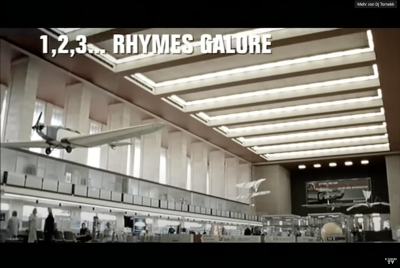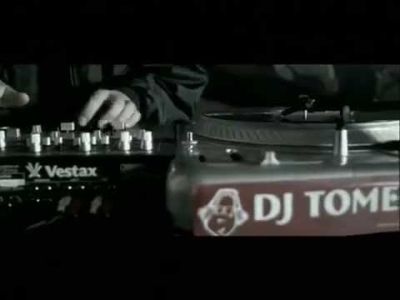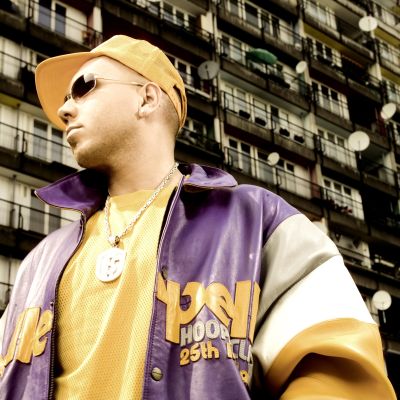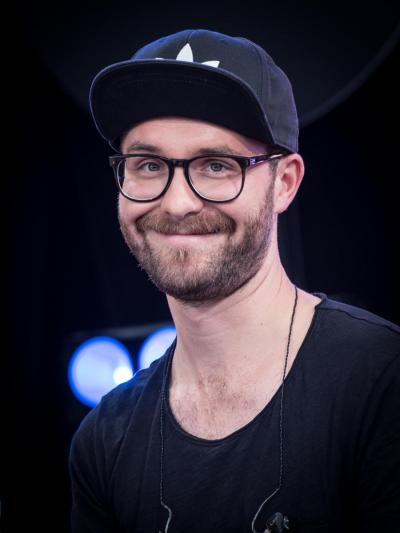He lives for hip-hop: the legendary DJ Tomekk
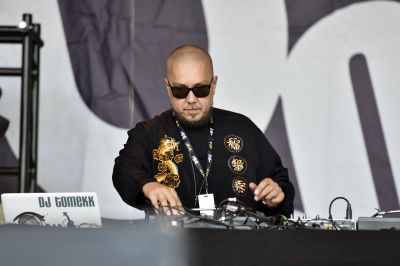
Tomasz Kuklicz was born on 11 October 1975 in Kraków. His creative talent and thirst for knowledge seemed to be in his DNA. One of his grandfathers was a successful painter, sculptor, and globetrotter, leaving the family a rich collection of paintings and sculptures after his death. His other grandfather was an architect. Tomasz’ parents, Dorota and Stanisław Kuklicz, had degrees in geology and were liberal intellectuals who supported their children’s development from an early age. During their childhood, Tomasz and his younger sister, Joanna, therefore lived in comparative prosperity and in a loving family. Despite his father’s alcoholism and frequent work trips, however, Tomasz developed closer emotional ties to him than he did to his mother. In the hope of making a better life for themselves and their children, the Kuklicz parents planned to leave socialist Poland and emigrate to Chicago in the US. Their plans were dashed when, on the night of 12 December 1981 martial law was imposed in Poland. The military and police assumed control. Several thousand supporters of the opposition were interned, tanks rolled through the winter streets, a curfew was imposed, and it was impossible to leave the country. With the constant shortages and rationing of food, Tomasz’ family became caught up in the everyday hardships and hunger that were typical of the time. When, in 1985, his father Stanisław finally found a way to emigrate to West Germany, he initially left his wife and children behind. From that time on, the young Tomasz travelled to and fro between two worlds: between his father and mother, West Germany and Poland.
Tomasz initial fascination for DJ-ing began when he read in the West German youth magazine “Bravo” about a British DJ who recorded songs from the radio and mixed the samples to create new music. Inspired by this form of musical expression, he then made his first highly promising attempts using his mother’s cassette recorder and various other recording media. In 1986 he met a real-life DJ for the first time in a Kraków jazz club. The 11-year-old Tomasz, who was eager to learn more, asked “DJ Witek” to teach him the basics of the craft. For the young boy, this experience firmly cemented his desire to later become a DJ himself. That same year, Tomasz followed his father to West Berlin, and only spent the summer holidays with his mother in Poland. Father and son moved into an apartment in Bastianstrasse 7 in Berlin-Wedding, where they lived modestly. At first, the language barrier and his few social contacts made Tomasz feel like an outsider in Germany. Despite feeling excluded, however, the self-confident, ambitious boy diligently learned German. He first attended the primary school in Gesundbrunnen and later the Diesterweg-Gymnasium grammar school. However, a certain amount of conflict did arise between the school authorities and the Polish boy from the problem area, whom they did not regard entirely without prejudice. He spent his free time on his creative and artistic work: drawing, graffiti, and rap. During this period, the hip-hop scene in Germany was still very small, and German rap was still in its infancy. However, since the early 1980s, the US hip-hop movement had at least gained attention in Germany, with songs such as “(You Gotta) Fight for Your Right (to Party!)” by the Beastie Boys and “Walk This Way” by Run-D.M.C. receiving a large amount of airplay and ranking high in the charts in 1986. This was the new, young sound of Berlin, whose subculture was organised through the city’s youth centres. At the youth club in Badstrasse in Berlin-Wedding, not far from where he lived, Tomasz found people who shared his interests. There, he successfully took part in creative graffiti and social integration competitions and saved up for his first record player by taking on graffiti and design jobs.
At home, though, the neglected boy took on responsibility for the household and the care of his alcoholic father. His father, Stanisław, who owned a small building company, ran into worsening financial difficulties and became increasingly beholden to his addiction and prone to violent behaviour, some of which was directed against his son. Tomasz became the target of his father’s attacks with increasing frequency. He avoided spending time at home as much as he could and learned early on to stand on his own two feet. When his father died from the effects of alcoholism in 1991, Tomasz, who was just 15 and a half-orphan, was suddenly left to fend for himself. There was no question of his returning to Poland, and at his own request, his mother gave her permission for him to stay in Germany. Tomasz spent the last few years until he came of age in the Frohsinn (“Happiness”) children’s home in Berlin-Wedding. During that period, he devoted a great deal of his time to DJ-ing, spending up to eight hours a day practising scratching, sampling, and remixing at the turntables. He made use of his contacts within the small Berlin hip-hop scene, DJ-ed at private parties and school events, and developed his own style, mixing hard beats with soft vocals. It didn’t take long until he made his big breakthrough.
At just 15, Tomasz signed his first record deal as a rapper with the “Stuff Records” label and released his first single under his rap moniker “MC Mis One” with the songs “Wait In Love For You” and “Art Gangster Rap”. He gained his first experience as a touring DJ with the Berlin musicians’ collective “Reality Brothers”. Starting in 1992, he DJ-ed in the “Acud” club in Berlin on Friday nights. As the weeks went by, the dancefloor grew fuller and fuller; in time, he became known in the Berlin scene under his new artist’s name “DJ Tomekk” (“Tomek” is a pet name for Tomasz; the added “k” stands for his surname, Kuklicz). In 1993, he began working as a DJ with the new Berlin-based radio station “Kiss FM”, presenting his own hip-hop show, “Boogie Down Berlin”, in German, Polish and English. Every Friday and Saturday evening, he mixed his music, interviewed well-known musicians and other guests, and even rapped himself in different languages for his steadily growing audience. It was thanks to his extraordinary talent and a stroke of luck that he got his major break in the music business. In 1993, the US hip-hop legend Kurtis Blow came to Kiss FM for an interview with the now 17-year-old Tomekk and was immediately impressed by his skills. That same evening, Kurtis Blow took the ambitious young Tomekk with him to his concert in Berlin as the opening DJ – and then contracted him to join him on tour through the US. A year later, Tomekk toured the US as a DJ with Kurtis Blow, played at concerts all over the country in front of several hundred thousand people, and was suddenly sharing a stage with the stars of the US hip-hop scene, including Run-D.M.C. and LL Cool J. Kurtis Blow acted as a mentor to the young Tomekk, and made sure that he got a good reception in the hip-hop scene. Regardless of the “East Coast vs. West Coast” conflict that raged in the US hip-hop world and which divided it into two enemy camps during the mid-1990s, Kurtis Blow, who did not have to stoop to such low-level arguments, introduced Tomekk to all the famous hip-hop artists from the East and West Coast alike. At that time, a white non-American was almost unheard of in the US hip-hop scene. It caused a huge stir, therefore, when in 1994 Tomekk was nominated for the “1st Annual Rap Music Award”.
After returning to Germany, Tomekk went back to school. However, he never got around to taking his “Abitur” school-leaving exams. While he may have sat in the classroom during the day, he spent the nights in various Berlin clubs, became joint owner of smaller and bigger club venues, and worked hard on furthering his career as a DJ. He sold his mix tapes, on which he frequently blended US and German artists into one song, from the boot of his car, as it were, and in so doing, bolstered his still very meagre bank balance. Once he came of age, he left the children’s home in Wedding and moved into his first apartment, before later renting a room in a shared flat with friends. In 1997, he signed a contract with the music executive Guido Schulz. From then on, he celebrated one success after another. He left school to work on productions in the major music studios, met real music producers, and took on remix contracts for artists who were friends. In 1998, together with Guido Schulz and his flatmate at the time, now the successful music manager Ronny “Ernie” Boldt, he founded the “Hip-Hop-Büro Berlin” DJ promotion agency. And when the sportswear brand Fila founded the “F-Records” label in 1999, Tomekk was one of the first artists to sign a contract. The song “1, 2, 3 Rhymes Galore”, an international cooperation between DJ Tomekk and Grandmaster Flash, became a huge commercial success and remained in the German charts for several weeks. His second single, “Ich lebe für Hip Hop” (“I live for hip-hop”) reached no. 11 on the charts. Even at this early stage, the hip-hop anthem became his signature trademark, reaching beyond his own musical milieu. He began appearing on TV, recorded songs such as “Comet” and “Bravo-Otto”, gave autograph sessions and received requests for bookings all over Europe. In 2001, he released his first album, “Return of Hip Hop”, and moved to New York that same year. Since then, he has recorded with major international stars and has enjoyed international chart success. At the dawn of the new millennium, Tomekk was one of the most famous hip-hop DJs and most sought-after producers in Germany. He helped a large number of German rappers gain success in the charts and brought US hip-hop artists to Germany, including LL Cool J, Coolio, Grandmaster Flash, Public Enemy, KRS One and the Wu-Tang Clan. A second studio album, “Beat of Life, Vol. 1” followed in 2002. In 2003, it was even nominated for a Grammy Award. In 2005, he released his third album, “Numma Eyns”, from which the single “Jump Jump (DJ Tomekk kommt)” made it to no. 3 on the German charts. The music video that accompanied the song was most expensive German hip-hop video to date.
His talent for creating hits with superstars from a range of different musical genres garnered him multiple golden discs and awards, as well as a considerable amount of money. During the 2000s, while hip-hop was developing into a million-dollar business in Germany, he earned a small fortune. Despite being an exceptional artist, he was also the subject of controversy, however. He made music for advertising campaigns and became one of the first symbols of the commercialisation of German hip-hop, earning him criticism from members of the hip-hop community in Germany who accused him of “selling out.” His increasing problems with alcohol and drug abuse attracted unflattering media attention. The real crisis came in 2008, when a private video emerged showing Tomekk giving a Nazi salute. This led to an onslaught by the tabloid press. Tomekk issued a highly plausible statement, saying that the video had been taken out of context, and that with his migration background and the diverse group of people with whom he was connected, he was by no means a supporter of racist or right-wing ideology. He took one reporter to court for defamation. The trial ended with a settlement, and with a bad hit to Tomekk’s reputation, the effects of which persisted for several years. In 2010, he released his fourth album, “Ehrenkodex” under a Polish label, featuring German and Polish artists. In the years that followed, his alcohol abuse intensified and he suffered several personal setbacks. However, the DJ legend succeeded in overcoming his alcoholism and found his feet again, feeling stronger and fitter. Nowadays, Tomekk, who is in his late 40s, leads a quieter life, although he still DJs regularly on the radio to a large audience, as well as at clubs and festivals all over the world. DJ Tomekk continues doing what he always has: hip hop.
Katarzyna Salski, May 2022
The autobiography “Ich lebe für Hip Hop” by DJ Tomekk was published in 2020 by the Heyne-Verlag.
